
a web page by Don Roberson |
 |
| Deep in the gloom of an Old World jungle a pitta stands motionless, giving a characteristic whistle. You, a potential observer, know that if you could see it, it will be a memorable experience, as pittas are wonderfully colorful. But they are also characteristically elusive, and more often than not, the pitta disappears unseen. Photography would seem impossible. Indeed, for all my visits to tropical rainforests, this shot of Sulawesi Pitta (above) is my best effort. [Sulawesi Pitta is a recent split from Red-bellied Pitta; more on that below]. The collection of photos below are from other photographers — I stand in awe at their inspiring accomplishments. Alas, much of my time in Old World was pre-digital. Digital photography has made pittas a bit more accessible — yet, still, each encounter is memorable. |
PITTAS Pittidae |
|
Other birders have similar feelings. Chris Gooddie, a British birder, became so smitten with them that he took a year off work to search out the (then) 32 species in the world. He has written a very entertaining book about his experiences (Gooddie 2010). |
|
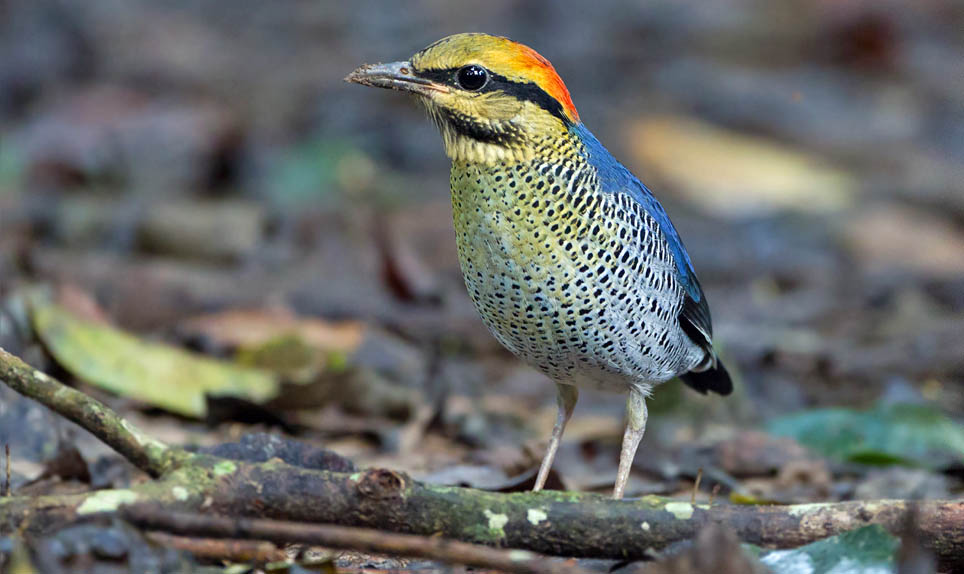 |
The Asian mainland also has impressive pittas, including Blue Pitta (above in an excellent shot by J.J. Harrison). This pitta appears to be at the spot in Khao Yai where some elusive species become accustomed to being fed mealworms. We visited the spot in January 2013 — by then a rare Orange-headed Thrush Geokichla citrina greeted us but the 'acclimatized' Blue Pitta did not appear. There are also two pittas in tropical Africa. This one (below) is Green-breasted Pitta, in another fine shot by Gareth Knass. Again, I have spent a day searching for it at a "known" location in Uganda, and again the great bird has eluded me. |
 |
Another clade was named Erythropitta. These are mostly small species with short tails, lots of red on the underparts, and greenish or bluish backs. There was initially six species in this genus, but that has now tripled when Red-bellied Pitta E. erythrogaster was split into 17 species (more on that below). |
In a recent visit to Thailand, guide Nik Upton located a pair of Eared Pitta (right; photo by N. Upton) deep in the understory. Like many pittas, it was not particularly shy but just cryptic and very difficult to view after each hop across the littered ground. This photo is of the adult female of the pair. |
This Javan Banded-Pitta (left, photo by Doug Janson from wiki-commons) is banded, and may have been part of a field study. Then, Irestedt et al. (2013) did a complete review of the entire Red-bellied Pitta set. They used both nuclear and mtDNA, combined with vocal and morphological evidence, and "based on all available evidence" they proposed that the E. erythrogaster complex is composed of 17 species. Irestedt et al. (2013) called the former "E. erythrogaster" the "great speciator." The nominate race of the formed "Red-bellied Pitta," erythrogaster, is endemic to the Philippines. And, as mentioned above, Sula Pitta E. dohertyi had already been split by some. The net is 15 new proposed species: (1) Talaud Pitta E. inspeculata, (2) Sulu Pitta E. yairocho, (3) Siao Pitta E. palliceps, (4) Sangihe Pitta E. caeruleitorques, (5) Sulawesi Pitta E. celebensis, (6) Buru Pitta E. rubrinucha, (7) Seram Pitta E. piroensis, (8) Louisiade Pitta E. meeki, (9) Moluccan Pitta E. rufiventris, (10) New Ireland Pitta E. novaehibernicae, (11) New Britain Pitta E. gazellae, (12) Tabar Pitta E. splendida, (13) Habenicht’s Pitta E. habenichti, (14) D’ Entrecasteaux Pitta E. finschii, and (15) Papuan Pitta E. macklotii. Nearly all are island endemics and nearly all are field identifiable on plumage. Papuan Pitta is widespread across much (but not all) of New Guinea, plus the Kai, Aru, and w. Papuan islands. Habenicht's Pitta is the lowland and foothill species in northern New Guinea. It is perhaps the most controversial of all the splits and was not adopted by the most recent New Guinea field guide, which did not split any of the "Red-bellied" pittas and stated that Papuan and Habenicht's are "not reliably identifiable by appearance or voice;" (Pratt & Beehler 2015). The molecular evidence shows substantial differentiation, so there is work to be done on these little-known taxa. Irestedt et al's (2013) proposal of the 17-way split was adopted by the Clements and eBird world checklists in 2014, bringing the world pitta total to 49 species. As there are several other endemic pittas in the Philippines, E. erythrogaster was not called "Philippine Pitta" but, instead, the old name Blue-breasted Pitta was reasonably adopted for this new Philippine endemic. Personally, I had recorded 4 of the 17 taxa in the old "Red-bellied Pitta" complex, but one of those was "heard only," so my net was only two extra lifers, with some 14 still unseen. One of the 'new' species accepted out of the split of the former "Red-bellied Pitta" is on Sulawesi. My distant photo of a half-hidden adult is at the top of this page. Here (below, a photo by Jason Thompson from wiki-commons) is a very fine photo of a Sulawesi Pitta in juvenal plumage, just started to molt into adult plumage with new green, blue, and red feathers appearing on the underparts. |
 |
Chris Gooddie accomplished his goal of seeing all the pittas at the time when 32 species were widely accepted as the full set. Now there are 49 species and counting. I wondered how many he still has left to see if he used the newest taxonomy. So I wrote him and the answer was that, except for the "Red-bellied" group, none. He was aware of pending splits in "Banded Pitta" and potential splits in Elegant Pitta, so he saw all of them except the vigorsii race of Elegant [Tanimbar and Kai islands in eastern Indonesia; this was once split by Clements but is lumped again in recent editions]. Chris says that he has continued to travel and see additional races of several pittas, but he is still 12 short of the entire 17-species-set of the now-split "Red-bellied Pitta." He agreed that it is likely there are some "cryptic species" in the complex, but thought that there is "so much vocal variation" within the known taxa, and so much to be learned about the remote island birds, that it was "too early to split Red-bellied complex." |
If I expanded by "top 50" birds in the world to a hundred, I'd surely add several more pittas. So many are just drop-dead gorgeous, including Rainbow Pitta of northern Australia (right, in an exceptional shot by David Fisher). They are all shy and secretive, with ethereal voices that draw one far from trails into primeval tropical forests in the Old World. My personal best memory was at Danum Valley, Borneo, and I wrote of it in my daily notes that evening (below, notes from 4 Aug 2003). I really really really wanted to see the endemic Blue-headed Pitta, so after a rainstorm one afternoon, I hike out a trail to a spot where we had heard one the day before. I sat down quietly near the end of a log, and briefly played a tape. To my shock, "the male Blue-headed Pitta appeared at the end of the log where it looked around, shook itself, and puffed out breast / belly (see sketch). Absolutely crippling views. It hopped down log towards me a bit before flying off." Returning home, I even tried to do a painting of the encounter with the Blue-headed Pitta (below, now embedded in color among my field notes). Still, I'm far from Chris Gooddie in terms of success — I've barely seen a quarter of the world's pittas. Just another good reason to take yet another long trans-Pacific flight to a forest in the lowlands of southeast Asia . . . . |
 |
Photos: The distant Sulawesi Pitta E. celebensis was at Tamun, Bogani Nani Wartabone NP, Sulawesi, Indonesia, on 6 Oct 2011. Gareth Knass photographed the Black-headed Pitta P. ussheri along the Kinabagaton River, Sukau, Sabah, in March 2005. Rob Hutchinson photographed the Ivory-breasted Pitta P. maxima near Foli, Halmahera, on 8 Oct 2011. J.J. Harrison photograph the Blue Pitta P. cyanea at Khai Yai NP, Thailand, on 29 Nov 2012. Gareth Knass photographed the Green-breasted Pitta P. reichenowi at Kanyanachu, Kibale NP, Uganda, in Feb 2006. Arthur Grosset photographed the Noisy Pitta P. versicolor at Paluma, Queensland, Australia, in Dec 2010. Nick Upton photographed the Eared Pitta Hydrornis phayrei at Khao Yai NP, Thailand, on 26 Dec 2012. Doug Janson photographed the Javan Banded-Pitta H. guajanus on Java on 31 May 2003. Jason Thompson photographed the juvenal-plumage Sulawesi Pitta E. celebensis at Tangkoko, Bogani Nani Wartabone NP, Sulawesi, Indonesia, on 24 Oct 2013. Steve Wilson photograph the Hooded Pitta P. sordida
when it crossed a Magnificent Bird-of-Paradise display ground at Baiyer
River Sanctuary, Papua New Guinea, on 27 Oct 1983 (Steve was in a
blind). David Fisher photographed the beautiful Rainbow Pitta P. iris in northern Australia. My sketch and painting of Blue-headed Pitta Hydrornis baudii, is from Danum Valley, Sabah, Malaysia, on 4 Aug 2003. Family Book:
Obviously another a fine introduction to this family, with some fabulous photos, is in Erritzoe (2003). Literature cited:
|
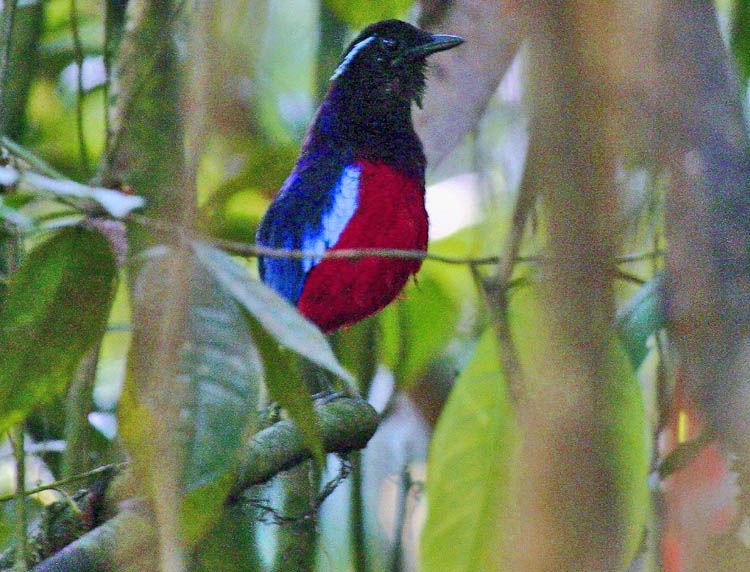 The
Pittidae is a fairly small family of mid-sized, short-tailed,
long-legged ground-dwelling jewels in the Old World tropics. I've spent
hours trying to track down calling birds inside Bornean forests, and
encounters there with Blue-headed Pitta Hydrornis baudii, Giant Pitta H. caerulea, and Black-headed Pitta were absolute highlights (see also the bottom of this page). Here (left) is a very nice shot of Black-headed Pitta by Gareth Knass. If pressed, I'd choose pittas as my favorite family of birds in the world.
The
Pittidae is a fairly small family of mid-sized, short-tailed,
long-legged ground-dwelling jewels in the Old World tropics. I've spent
hours trying to track down calling birds inside Bornean forests, and
encounters there with Blue-headed Pitta Hydrornis baudii, Giant Pitta H. caerulea, and Black-headed Pitta were absolute highlights (see also the bottom of this page). Here (left) is a very nice shot of Black-headed Pitta by Gareth Knass. If pressed, I'd choose pittas as my favorite family of birds in the world.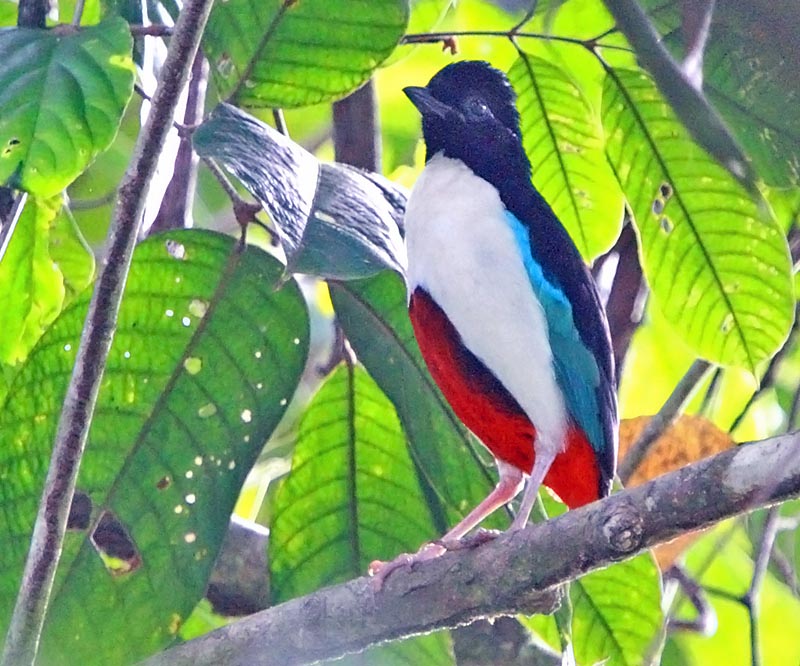 Pittas
are particularly associated with the islands of the Indo-Pacific.
Borneo, the Philippines, New Guinea, and many Indonesian and Melanesian
islands host endemic pittas. The absolutely gorgeous Ivory-breasted Pitta
(right, a wonderful shot by Rob Hutchinson) is endemic to Halmahera and
nearby Moluccan islands. I was with Rob when he called in this
individual with a tape, and the bird appeared only briefly. Rob managed
this great shot; mine was distant and marginal. It is truly remarkable
how difficult these colorful birds are to see. Unless they decide to
fly briefly up to a perch (as this one has done) they seemingly melt
away in the understory.
Pittas
are particularly associated with the islands of the Indo-Pacific.
Borneo, the Philippines, New Guinea, and many Indonesian and Melanesian
islands host endemic pittas. The absolutely gorgeous Ivory-breasted Pitta
(right, a wonderful shot by Rob Hutchinson) is endemic to Halmahera and
nearby Moluccan islands. I was with Rob when he called in this
individual with a tape, and the bird appeared only briefly. Rob managed
this great shot; mine was distant and marginal. It is truly remarkable
how difficult these colorful birds are to see. Unless they decide to
fly briefly up to a perch (as this one has done) they seemingly melt
away in the understory.  Pittas
have always been thought of as a cohesive group of 24-32 species (e.g.,
Lambert & Woodcock 1996, Erritzoe 2003). Irestedt et al. (2006)
used molecular evidence to show that there were three major clades
within the family, and divided them into three genera. The first-named
genus Pitta had the 14 species. The two African species are in this genus, as is Indian Pitta P. brachyura.
Pittas in this genus have green upperparts with a blue wing-patch and
contains all the migratory species, like Blue-winged Pitta P. moluccensis and Noisy Pitta. Noisy Pitta
(left, in a photo be Arthur Grosset) breeds in eastern Australia in the
southern summer and then 'winters' in New Guinea. Many of the island
endemics are presumably derived from migratory species.
Pittas
have always been thought of as a cohesive group of 24-32 species (e.g.,
Lambert & Woodcock 1996, Erritzoe 2003). Irestedt et al. (2006)
used molecular evidence to show that there were three major clades
within the family, and divided them into three genera. The first-named
genus Pitta had the 14 species. The two African species are in this genus, as is Indian Pitta P. brachyura.
Pittas in this genus have green upperparts with a blue wing-patch and
contains all the migratory species, like Blue-winged Pitta P. moluccensis and Noisy Pitta. Noisy Pitta
(left, in a photo be Arthur Grosset) breeds in eastern Australia in the
southern summer and then 'winters' in New Guinea. Many of the island
endemics are presumably derived from migratory species. 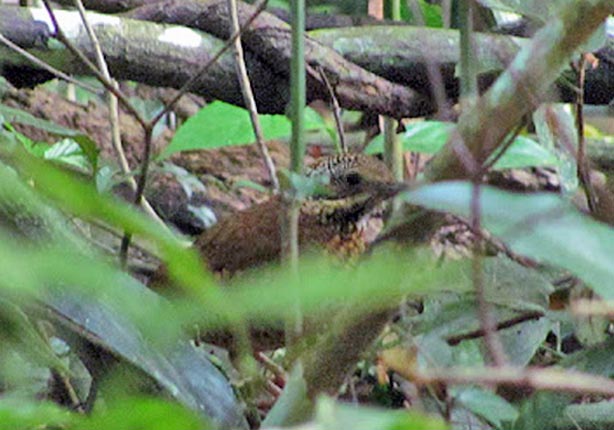 The final genus, Hydrornis,
includes some variable Oriental species that are sexual dimorphic in
plumage and have a cryptic juvenile plumage in the species that have
been studied. This genus includes Eared Pitta which had often been
placed into its own genus ["Anthocincla"] because of its alleged primitive characters.
The final genus, Hydrornis,
includes some variable Oriental species that are sexual dimorphic in
plumage and have a cryptic juvenile plumage in the species that have
been studied. This genus includes Eared Pitta which had often been
placed into its own genus ["Anthocincla"] because of its alleged primitive characters. 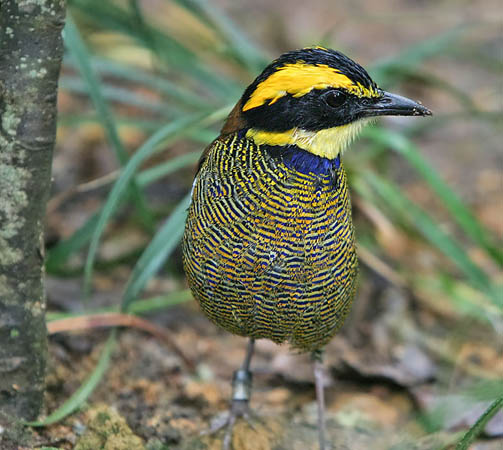 A
number of world checklists within the last 50 years listed as few as 24
species. This was after the great heydays of lumping in the mid-20th
century. This contrasts with the lists of of Sclater and Elliot at the
end of the 19th century that contained 48 and 47 species, respectively
(Erritzoe 2003). Now, in 2014, we are back with the numbers envisioned
by 19th century ornithologists. It began with the book on pittas and
relatives (Lambert & Woodcock 1996) that split Sula Pitta E. dohertyi from the widespread Indo-Pacific Red-bellied Pitta on morphological grounds. Then Rheindt and Eaton (2010) split Banded Pitta Hydrornis guajanus is split into three species: Malayan Banded-Pitta H. irena, Bornean Banded-Pitta H. schwaneri, and Javan Banded-Pitta H. guajanus. These splits were widely accepted (as was the split of Black-headed E. ussheri from Garnet Pitta E. granatina in the Sundaic region), bringing the list to 34 species.
A
number of world checklists within the last 50 years listed as few as 24
species. This was after the great heydays of lumping in the mid-20th
century. This contrasts with the lists of of Sclater and Elliot at the
end of the 19th century that contained 48 and 47 species, respectively
(Erritzoe 2003). Now, in 2014, we are back with the numbers envisioned
by 19th century ornithologists. It began with the book on pittas and
relatives (Lambert & Woodcock 1996) that split Sula Pitta E. dohertyi from the widespread Indo-Pacific Red-bellied Pitta on morphological grounds. Then Rheindt and Eaton (2010) split Banded Pitta Hydrornis guajanus is split into three species: Malayan Banded-Pitta H. irena, Bornean Banded-Pitta H. schwaneri, and Javan Banded-Pitta H. guajanus. These splits were widely accepted (as was the split of Black-headed E. ussheri from Garnet Pitta E. granatina in the Sundaic region), bringing the list to 34 species. 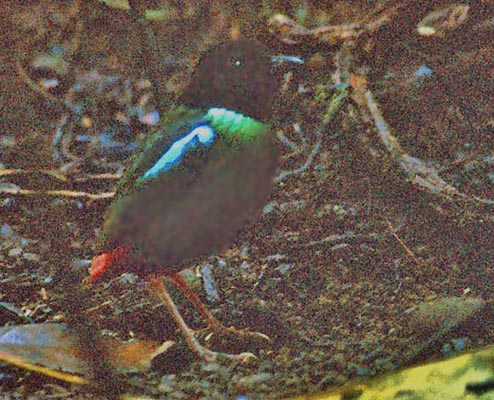 The
former "Red-bellied Pitta" was widespread in range from the Philippines
to the Solomon Island. The other Indo-Pacific pitta with numerous races
is Hooded Pitta (left; a photo from Papua New Guinea
by Steve Wilson). There are at least 12 races, some black-crowned and
some chestnut-crowned. No one has yet done a molecular phylogeny of
this complex. Are there still more "new" pittas to come?
The
former "Red-bellied Pitta" was widespread in range from the Philippines
to the Solomon Island. The other Indo-Pacific pitta with numerous races
is Hooded Pitta (left; a photo from Papua New Guinea
by Steve Wilson). There are at least 12 races, some black-crowned and
some chestnut-crowned. No one has yet done a molecular phylogeny of
this complex. Are there still more "new" pittas to come? Pittas are so wonderful that I list two pittas — Gurney's Pitta H. gurneyi and Giant Pitta H. caeruleais — among my "
Pittas are so wonderful that I list two pittas — Gurney's Pitta H. gurneyi and Giant Pitta H. caeruleais — among my "